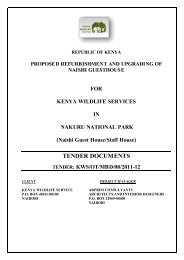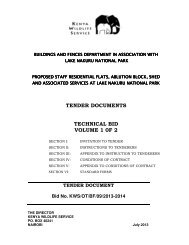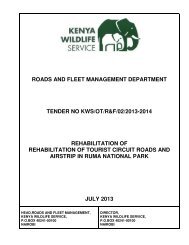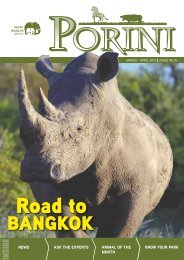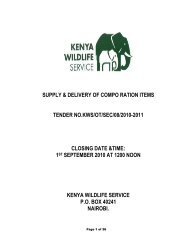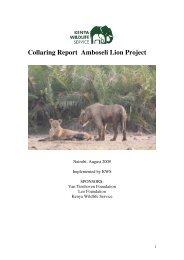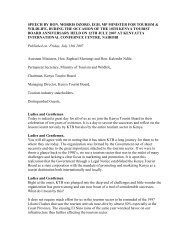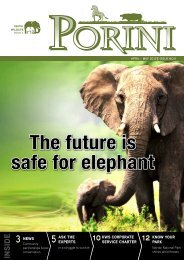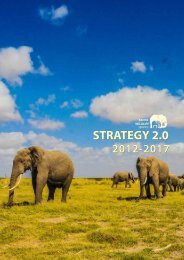Conservation and Management Strategy for the Elephant in Kenya
Conservation and Management Strategy for the Elephant in Kenya
Conservation and Management Strategy for the Elephant in Kenya
You also want an ePaper? Increase the reach of your titles
YUMPU automatically turns print PDFs into web optimized ePapers that Google loves.
“<br />
CONSERVATION AND MANAGEMENT STRATEGY FOR THE ELEPHANT IN KENYA xx<br />
This new <strong>Strategy</strong> is a statement of <strong>the</strong> country’s cont<strong>in</strong>u<strong>in</strong>g ef<strong>for</strong>ts<br />
to secure a safe <strong>and</strong> last<strong>in</strong>g future <strong>for</strong> this widely-celebrated national<br />
treasure <strong>in</strong> an atmosphere of grow<strong>in</strong>g threats <strong>and</strong> ever-more<br />
challeng<strong>in</strong>g circumstances; most notably <strong>the</strong> growth of human<br />
populations <strong>and</strong> <strong>the</strong> concomitant loss of habitat<br />
”<br />
This new <strong>Strategy</strong> <strong>for</strong> <strong>the</strong> conservation <strong>and</strong> management of <strong>Kenya</strong>’s elephants is both long overdue <strong>and</strong><br />
all-<strong>the</strong>-more necessary now than ever be<strong>for</strong>e because despite <strong>the</strong> cont<strong>in</strong>u<strong>in</strong>g recovery of <strong>the</strong>ir national herds, <strong>the</strong>re<br />
is no obvious reason <strong>for</strong> complacency. Like all its fellow African elephant range States, <strong>Kenya</strong> faces serious <strong>and</strong><br />
grow<strong>in</strong>g challenges on many fronts. <strong>Kenya</strong>’s proximity to neighbour<strong>in</strong>g countries at war, <strong>and</strong> <strong>the</strong> accompany<strong>in</strong>g <strong>and</strong><br />
<strong>in</strong>evitably uncontrollable flow of arms, renders <strong>the</strong> nation <strong>and</strong> its elephants at cont<strong>in</strong>ued risk; all <strong>the</strong> more worry<strong>in</strong>g<br />
<strong>in</strong> <strong>the</strong> face of a grow<strong>in</strong>g <strong>and</strong> potentially <strong>in</strong>satiable dem<strong>and</strong> <strong>for</strong> ivory as a luxury item <strong>in</strong> emerg<strong>in</strong>g economies of <strong>the</strong><br />
world. And with <strong>Kenya</strong>’s steadily grow<strong>in</strong>g human population, shr<strong>in</strong>k<strong>in</strong>g areas of arable l<strong>and</strong>, <strong>and</strong> limited long-term<br />
l<strong>and</strong>-use plann<strong>in</strong>g at <strong>the</strong> national level, <strong>in</strong>creas<strong>in</strong>g conflict between <strong>the</strong> country’s rural communities <strong>and</strong> its<br />
elephants is <strong>in</strong>evitable. Indeed, a difficult future to navigate.<br />
“<strong>Conservation</strong> <strong>and</strong> <strong>Management</strong> <strong>Strategy</strong> <strong>for</strong> <strong>the</strong> <strong>Elephant</strong> <strong>in</strong> <strong>Kenya</strong> (2012 – 2021)” represents <strong>the</strong> hard work of many<br />
dedicated conservation professionals <strong>and</strong> <strong>the</strong> voices of many who were given <strong>the</strong> opportunity to actively participate<br />
<strong>in</strong> its <strong>for</strong>mulation. While it identifies <strong>the</strong> current threats, it also explores <strong>the</strong> emerg<strong>in</strong>g opportunities <strong>and</strong> provides a<br />
framework <strong>for</strong> coord<strong>in</strong>ated <strong>and</strong> concerted action over <strong>the</strong> next ten years to assure <strong>the</strong> persistence of elephants <strong>in</strong><br />
<strong>Kenya</strong>, both as an economic asset <strong>for</strong> its national constituency, <strong>and</strong> as a symbol of <strong>Kenya</strong>’s deep commitment to <strong>the</strong><br />
conservation of biodiversity. In jo<strong>in</strong><strong>in</strong>g 10 of <strong>the</strong>ir fellow African elephant range states to undertake such a targeted<br />
<strong>and</strong> dedicated plann<strong>in</strong>g approach <strong>for</strong> <strong>the</strong> conservation <strong>and</strong> management of elephants at <strong>the</strong> national level, I hope<br />
it will serve as clarion call <strong>for</strong> o<strong>the</strong>rs to follow suit <strong>and</strong> a beacon of hope <strong>for</strong> <strong>the</strong> future of elephants over <strong>the</strong> com<strong>in</strong>g<br />
decade.<br />
Dr. Holly T. Dubl<strong>in</strong><br />
[ TOP ] Plate 14.<br />
<strong>Elephant</strong> translocations <strong>in</strong> Tsavo<br />
- Richard Kock<br />
[ RIGHT ] Plate 15.<br />
Rescu<strong>in</strong>g an orphaned elephant<br />
whose mo<strong>the</strong>r was killed by<br />
poachers <strong>in</strong> north-west Laikipia,<br />
- Max Graham, Space <strong>for</strong> Giants



